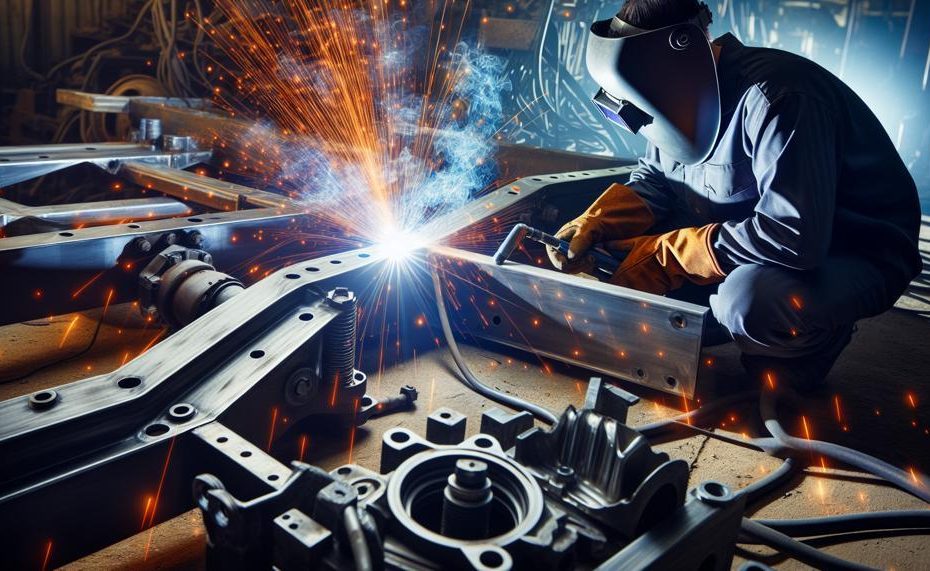Today, we’re tackling a question that often goes unnoticed – does welding weaken a chassis? As car enthusiasts, we know that a sturdy chassis is vital for a smooth and secure ride. But have you ever considered the impact of welding on this crucial component?
It may seem insignificant, but it can have significant repercussions on your vehicle’s overall structural integrity.
So, let’s take a deep dive into this topic and uncover the potential risks associated with welding on a chassis. Here are some key points to keep in mind:
- Welding introduces heat and stress to the metal, which can weaken it over time.
- Improper welding techniques or materials can lead to cracks or fractures in the chassis.
- A weakened chassis can compromise your vehicle’s handling and stability.
- Regular inspections and maintenance are essential for maintaining the strength of your chassis.
Join us as we unravel the effects of welding on a chassis and discover how you can prevent any potential issues from arising. Let’s get started.
Contents
Frame Welding Methods
When it comes to welding chassis, there are three main methods used: MIG welding, TIG welding, and stick welding. Each method has its own set of pros and cons, which ultimately impact the strength and durability of the frame in different ways.
Firstly, MIG welding is a popular choice for chassis welding due to its speedy process and clean results. However, if not done with proper technique or inadequate penetration, it can result in a weaker chassis.
On the other hand, TIG welding is known for its ability to produce strong and precise welds, making it a preferred method for chassis. However, it requires great skill and can be time-consuming.
Lastly, stick welding is commonly used for heavy-duty chassis that require high strength and durability. It produces deep penetration welds but can be challenging to control heat and requires frequent electrode changes.
Problems With Frames
Welding on a chassis can lead to a variety of problems, including heat distortion, brittle welds, and weakened suspension components. These issues can significantly impact the strength and stability of the vehicle, which can pose safety risks if not resolved correctly. Therefore, it is crucial for welders to utilize proper welding methods and adhere to appropriate procedures to reduce the occurrence of these problems and guarantee a robust and long-lasting chassis.
One of the most common issues when welding on a chassis is heat distortion. This occurs when too much heat is applied to the metal, causing it to warp and lose its shape. As a result, the chassis may become misaligned, affecting the overall performance and handling of the vehicle. To avoid this problem, welders should use lower heat settings and make multiple passes rather than applying excessive heat in one go.
Another issue that can arise is brittle welds. This means that the welds are prone to cracking or breaking under stress, which can be dangerous for the vehicle’s structural integrity. To prevent this, welders should ensure that they are using the correct welding technique for the type of metal being welded and that they are using high-quality welding rods.
Distortion of suspension components is another problem that can occur from welding on a chassis. This happens when too much heat is applied near suspension components, causing them to bend or deform. To avoid this issue, welders should use heat shielding and take breaks to allow the metal to cool down before continuing with welding.
Lastly, weakened welds can also be a major concern when welding on a chassis. This happens when welds are not done properly or when there are defects in the metal being welded. To ensure strong and durable welds, it is important for welders to follow proper welding procedures and thoroughly inspect their work for any issues.
Bending
The art of welding plays a crucial role in determining the strength and longevity of a chassis, especially when it comes to its ability to withstand bending.
The intense heat generated during welding has the potential to change the microstructure of the metal, resulting in a weaker material that is more susceptible to bending and twisting forces.
Additionally, incorrect welding techniques and procedures can introduce harmful residual stresses into the metal, further compromising its bending strength. Precision and adherence to proper welding methods and procedures are vital in preserving the structural integrity of the chassis.
Frame Welding Legal Issues
Welding on a truck frame can result in legal issues if not approached with caution. These can include safety hazards, damage to the structure, and possible violations of local and state laws. To avoid such consequences, it is essential to follow proper techniques and training, use proper protective gear, and comply with legal regulations.
| Legal Consequences | How to Avoid |
| Burns, eye injuries, exposure to harmful fumes and gases, electric shock hazards, fire hazards, and physical strain injuries | – Utilize appropriate personal protective equipment (PPE) – Follow proper training and techniques |
| Structural damage to the truck frame due to inadequate techniques or substandard materials | – Use proper welding techniques – Thoroughly clean materials before welding – Preheat if necessary – Inspect for discontinuities in the weld |
| Potential violations of local and state laws | – Seek guidance from legal professionals – Research laws before attempting any repairs |

Additionally, it is important to note that while federal law allows welding on truck frames, there may be specific rules and restrictions set by local and state regulations. Therefore, consulting with legal professionals and researching laws beforehand is crucial.
Frame Welding Procedure
When it comes to welding a truck frame, there are several crucial steps that must be followed to ensure a strong and durable weld.
It’s vital to comply with state regulations and guidelines, as well as reinforce weak spots and consult with authorities to avoid potential safety hazards on the road.
Choosing the Right Welding Technique:
The choice of welding technique plays a significant role in the strength and integrity of the truck frame. While MIG welding is commonly used for mass production, TIG welding is preferred for precise and intricate welds.
On the other hand, stick welding may be more suitable for repairing damaged frames but may not hold up well in high-stress applications.
Understanding Environmental Factors:
Environmental factors, such as humidity and temperature, can have a significant impact on the quality of welds.
It’s essential to monitor and adjust accordingly, as excessive humidity can cause porosity, while cold temperatures can result in brittle welds. Proper storage and preparation of materials can also help minimize these risks.
Using Alternative Welding Methods:
For those looking for alternatives to traditional welding techniques, laser beam welding and friction welding are worth considering.
These methods use high-energy beams or heat to join metal pieces, reducing the risk of weakening the chassis.
Compliance with Regulations and Guidelines:
Following state regulations and guidelines is crucial when welding a truck frame for commercial purposes. These regulations ensure that safety and quality standards are met, minimizing the risk of structural failure and potential legal issues.
Proper Preparation and Technique:
Proper preparation and technique are essential for achieving a sturdy weld. This includes cleaning the metal surfaces, using the correct filler material for the type of joint, and following proper welding procedures. Improper technique or inadequate training can lead to weak welds.
Monitoring Temperature and Reinforcing Weak Spots:
Welding can alter the properties of metal, making it crucial to monitor temperature and reinforce weak spots. This helps ensure that the weld will hold up well under stress and prevents potential issues down the road.
Consulting with Authorities:
Lastly, it’s always a good idea to consult with authorities when it comes to welding a truck frame.
Truck Frame Welding
Truck Frame Welding is a critical part of creating a strong and durable frame for a truck. This process involves heating and fusing together two or more pieces of metal to create a solid bond. However, if not done correctly, welding can weaken the frame and compromise its structural integrity.
Several factors can affect the strength of a truck frame, including stress points, material composition, and welding technique. Different welding methods can have varying effects on the frame’s durability. For instance, TIG welding is known for its precision and is preferred for welding crucial parts of the frame. On the other hand, MIG welding is faster and better suited for larger, less critical areas.
Improper welding techniques, inadequate training, subpar materials or equipment, and environmental conditions like humidity and temperature can all lead to weak welds. This can result in structural failure and alignment issues, putting the vehicle’s safety and performance at risk.
To prevent this, it is crucial to follow state regulations and guidelines for welding truck frames, use appropriate techniques and materials, properly prepare the metal surface before welding, monitor temperature during welding, inspect for existing cracks or defects before beginning any work, and seek professional assistance when needed.
Moreover, it is essential to consider the legal implications of frame welding for commercial purposes. In addition to traditional methods, newer techniques like Laser Beam Welding and Friction Welding are gaining popularity in the automotive industry due to their precision and effectiveness.
Resistance Spot Welding is also commonly used but can cause excessive heat input if not performed correctly.
Bike Frame Welding
Bike frame welding is a crucial step in creating a sturdy and durable bike frame. It is the process that bonds together the different components of the frame, and its quality can greatly affect the overall structural integrity and performance of the bike.
Types of Welding:
When it comes to bike frame construction, there are two main types of welding used: brazing and welding. While brazing involves using a filler material to join the base metals, welding involves melting the base metals and fusing them together.
The type of welding used depends on the materials used and the desired characteristics.
Brazing vs Welding:
Steel frames are often brazed due to its ability to create a strong bond without compromising overall strength. This method also keeps temperatures lower, minimizing the risk of distortion or weakening of the frame compared to welding.
Moreover, brazed joints are easier to repair or modify, making it a preferred method for steel frames.
On the other hand, welding is commonly used for aluminum and titanium frames as it creates a lighter and stiffer structure. This method results in a direct metallurgical bond between the materials, resulting in a stronger and more durable frame.
However, welding can also cause heat-related distortions, requiring more expertise and precision compared to brazing.
Impact on Strength and Durability:
The welding process has a significant impact on the strength and durability of a bike frame. While it creates a direct bond between materials, it can also create potential stress points or weak areas if not done correctly. To ensure strong and durable welds that can withstand the rigors of riding, proper training, preparation, and monitoring are crucial.
Furthermore, different welding techniques can have varying effects on the strength and durability of a bike frame. For instance, newer methods like Laser Beam Welding and Friction Welding are gaining popularity for their precision and ability to create strong bonds with minimal heat affected zones.
Traditional methods like TIG and MIG welding also have their strengths for specific areas of the frame.
Technicalities of Frame Welding
When discussing the process of welding on a chassis, there are numerous risks and challenges that must be taken into account. These include potential safety hazards, structural damage, and adherence to regulations.
Safety concerns are of utmost importance when performing welding on a chassis, as the intense heat and sparks generated during the process can pose significant dangers. Potential risks include burns from sparks or molten metal, ocular injuries from UV radiation and fumes, exposure to toxic gases, electric shock hazards, fire hazards, and physical strain injuries. Welders must therefore take necessary precautions to protect themselves from these hazards.
Aside from safety concerns, using inadequate techniques or materials during welding can also result in structural damage to the vehicle. This not only puts the welder at risk but can also compromise the overall integrity of the chassis.
Moreover, federal law permits welding on truck frames as long as it follows prescribed guidelines and precautions. However, local and state regulations may have additional rules and restrictions that should be taken into consideration before attempting any welding repairs on a truck frame.
To ensure safe welding practices and mitigate these risks, proper precautions should be taken. This includes utilizing appropriate personal protective equipment (PPE) such as a welding helmet with suitable lenses, gloves made with Kevlar material, a leather apron, and sturdy boots. It is also crucial to thoroughly prepare the work area by cleaning the surface being welded and removing any flammable materials or debris from the vicinity.
Inspecting all equipment used for welding before starting the process is also essential to ensure safe operation. It is recommended to have a fire extinguisher nearby at all times in case of an emergency during welding.
Various options for truck frame repair include MIG (Metal Inert Gas) welding for quick and efficient repairs, TIG (Tungsten Inert Gas) welding for precise results, and stick welding (Shielded Metal Arc Welding) for commonly used repairs. Each of these techniques has its own challenges and risks that must be taken into consideration and managed.
Conclusion
In conclusion, welding on a chassis can have significant implications for the overall strength and durability of a vehicle. It is a crucial aspect that requires attention to detail and proper techniques to ensure the safety and reliability of the truck frame.
However, this process is not without its risks. Heat distortion, brittle welds, and weakened suspension components are just some of the potential dangers that come with welding on a chassis. Not to mention the legal consequences if not approached with caution.
To mitigate these risks, there are crucial steps that must be taken. Choosing the right welding method, understanding environmental factors, complying with regulations and guidelines, using alternative techniques, proper preparation and technique, monitoring temperature and reinforcing weak spots, and consulting with authorities are all essential in creating a strong and reliable chassis.
As car enthusiasts, we understand the importance of a sturdy chassis for a smooth and safe ride. And as automotive engineers and designers, it is our responsibility to continuously explore the intricacies of building a safe and reliable vehicle.
By delving into the effects of welding on a chassis, we can better understand how to prevent potential issues from arising and ensure structural integrity for years to come.





